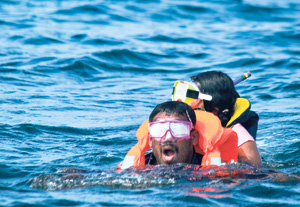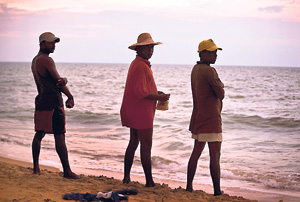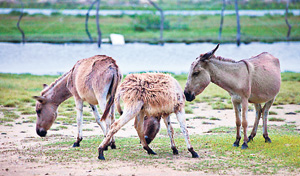Since childhood, I have struggled with a rebellious stomach. Prone to motion sickness, in trains, planes, cars, and even on the playground swings, I have never been out to sea before. Now, the small 8- person fishing boat before me affords me little comfort, but I console myself with the thought of motion sickness pills consumed, tighten the straps on my life vest and step on board. I’m in this for the dolphins.
 |
| Snorkeling from the Bar Reef |
And here, on the west coast of Sri Lanka, might just be the best place to see them. Off the coast of the small town of Kalpitiya, pods numbering many hundreds are routinely spotted in the warm tropical waters. Stenella longirostris or spinner dolphins are famous for their acrobatics and our host tells us that on a clear day, you can sometimes stand on the shore and see the dolphins leaping and playing, their sleek bodies silhouetted against the distant horizon.
But for me, bereft of such hawk-like vision – the horizon looks rather bare. Undeterred, we hand over Rs.8,000 and put our trust in our fisherman guide, Ranil, and head out to sea.
An ocean safari
It’s the start of a gruelling, five hour long journey. Everywhere we go, the dolphins seem to have just passed by. We stop to ask several fishermen, as if asking for directions on a street corner, and they all reply with variations of, “they were just here, they’re moving fast in that direction…” and off we go again. 2 ½ hours pass and we still haven’t had any luck. My eight-year-old niece is terribly disappointed, as am I. The sun has risen and now beats down on us ferociously. We slather on sunscreen, dig out our hats, and unroll our sleeves to protect our arms. An apologetic Ranil tells us that we might have to console ourselves with a visit to the Bar Reef instead.
It’s another 15 minutes before we get there and Ranil can drop anchor. We’ve brought snorkels and flippers with us and we climb off the boat and swim across the submerged reef. It’s unlike anything I’ve ever seen – the coral seems to stretch for miles! My brother-in-law spots an octopus and a fleeing turtle and the children see shoals of brightly coloured reef fish. Butterflyfish, Bannerfish, Parrotfish, Groupers and even Black Tip Reef Sharks have been seen here. Designated a national sanctuary in 1992, the Bar Reef sprawls over an area of more than 300 square kilometres. Apparently, pearl banks and an ocean ridge in the near vicinity offer good scuba diving. Despite the abundance before me, I keep a wistful eye out for dolphins.
 |
| Fishermen in Kalpitiya |
 |
| Grazing wild asses |
 |
| Fishing boats add to the scenic view |
Finally, we decide to head back. However, Ranil isn’t ready to call it quits – he says he’s never had to spend so long and travel so far in search of dolphins before.
But he’s tenacious, and despite the protests of my parents, both of whom are looking decidedly green around the gills by this point, we head off in a new direction.
Another hour passes...and then Ranil sees something on the horizon. All the monotonous hours that came before are wiped out as we speed toward a distant spot.
There! A dark body spears out of the ocean, separating from the waves and then crashes back in. As we get closer, we see another and another and then they’re everywhere.
Surely there are more than a hundred. Alongside us, a graceful trio ride the crest of a wave in perfect synchronisation, several dive under the boat, weaving under and around the bow while up ahead a baby spinner twirls and leaps in a particularly joyous display. We’ve brought along whistles and we use these to call out to them.
They seem to respond, coming even closer. Lying flat on the bow, my niece and I look down into the clear water, watching the sleek forms, dappled with sun and shade, cut through the sea beneath us.
The temptation to jump in and join in the play is nearly irresistible. It’s a moment marked by pure delight and an unexpected, yet profound sense of connection.
More than just dolphins
On our way back we see two other boats, packed with tourists bundled into orange life vests. They are evidence of Kalpitiya’s growing popularity. The Kalpitiya season, from November to April, is marked by the arrival of many tourists. Those who attempt the 160km drive down from Colombo are pleased to find that for most part the roads are good and the traffic is light – only the last 40km after you take the Kalpitiya turn off are somewhat bumpy. The entire trip is about four hours, and takes you past salt marsh, clumps of mangrove trees, then past scrub jungle, beyond which lie rolling sand dunes. You might also pass Hotel Tanya Nature on Puttalam road, amazingly the only hotel in the area to be registered with the Tourist Board.
The dearth of Tourist Board approved hotels is some indication of the region’s infrastructure problems. While decidedly upmarket resorts like Alankuda (www.alankuda.com) are doing brisk business, we found it difficult to find mid-level accommodation in Kalpitiya. We decided to stay at Turtle Point in Kandakkuliya, a three-room cottage with a great view and easy access to the beach. However, at a cost of just over Rs. 5,000 a day for all of us, its very basic amenities did not include electricity. Lionel, the caretaker and his wife took good care of us – setting up a delicious seafood barbeque on request – and keeping the kerosene lamps lit after sundown.
In an adjacent plot of land, a new hotel is under construction - one of the many being quickly erected to cash in on the regions popularity. Controlled development of the area is expected under the auspices of The Kalpitiya Integrated Tourism Resort Development Project (KITRDP).
For now, the cottage’s remoteness suits us very well. The children and I attempt to make friends with some wild asses grazing nearby – the foals are ridiculously sweet. I only regret that we weren’t there on a poya, when the turtles come ashore to lay their eggs. But regular walks along the beach afford glorious panoramas of sea and sky. The occasional fisherman (it’s a good place to cast a line, if you are so inclined) actually contributes to an almost picture postcard view.
It’s difficult to get around if you don’t have your own transport, but there’s much else in the vicinity worth a visit. If you enjoy fresh seafood, go down to the docks in Kalpitiya town. Wholesalers sorting through catch fresh off the boat will be happy to sell you anything from lobsters, crabs and prawns to shark meat and even manta ray meat. The Old Dutch fort and church in Kalpitiya may appeal to amateur historians, as will the shrine to St. Anne at Talawila. Set amid arid dunes and palmyrah palms, the shrine, reportedly constructed in 1843, draws pilgrims to it from all over Sri Lanka during the Holy Week.
Kalpitiya lagoon, one of the largest in Sri Lanka, itself beckons explorers. Measuring 80km from north to south, the lagoon is dotted with numerous little islands, many of which are uninhabited and covered in green mangroves.
There are over 20 species of mangrove in Sri Lanka, and some of these, including endangered varieties like the kind known as “rathambilla” to the locals are found on these islands. Campers often find their way to the lower reaches of the Kala Oya, which flows through the nearby Wilpattu National Park.
In fact a portion of the lagoon falls within the park’s boundaries, and the area can be explored by boat. Across the lagoon at Pomparippu, a prehistoric burial ground contains ancient urns. A boat ride followed by a 5km trek through the jungle await would- be anthropologists.
Designs for
development
Despite Kalpitiya’s growing reputation as a tourist hot spot, development in the region has lagged behind – but not for long. The Kalpitiya Integrated Tourism Resort Development Project (KITRDP) is a multi-billion dollar undertaking that if successfully implemented might spawn a tourism industry to rival those on the South coast.
Though the development will primarily focus on the creation of luxury hotels on 14 islands in the Kalpitiya Lagoon, the peninsula itself will see development, says Additional Project Director for KITRDP Tissa Sooriyagoda.
The Sri Lanka Development Authority intends to encourage visitors to explore the Kalpitiya peninsula itself, perhaps even discovering nearby Wilpattu National Park through a gateway on the Kala Oya estuary. As for the islands, three projects – each with over a 100 rooms - are already underway and are expected to be opened to the public in 2012. The need to make sure that each project receives a full whetting might slow down the pace of development, but will ensure that the region’s rich natural resources are protected, says Mr. Sooriyagoda.
Rooms at the upmarket island resorts might eventually cost as much as $1000 per night. “Though this may sound like a miracle, it isn’t impossible, countries like the Maldives have done it,” he adds. Luxury will meet high environmental standards – all the new projects will be “green resorts”. “With all our investors, we have stressed the need for good practices, including generation of energy through alternative sources, careful management of fresh water, and waste disposal,” says Mr. Sooriyagoda.
Much of the basic infrastructure required to pull this off is currently missing. The islands will need to be connected, while on the peninsula facilities such as a hospital as well as a good transport network will need to be put in place – “we’ll need to do this because the mainland will be our gateway to the islands,” says Mr. Sooriyagoda.
Places to stay
Alankuda Beach Resort – +94(0)777 336699
Turtle Point Cottage – +94(0)112689544/
+ 94 (0)773560926
Dolphin Beach – + 94 (0)777896696
Kalpitiya Lagoon House – +94(0)773476288 / +94(0)112819457
Sethawadiya Dolphin View Eco Lodge – +94(0)772395370
Dancing Dolphin Cabanas – +94(0)112819457
|





